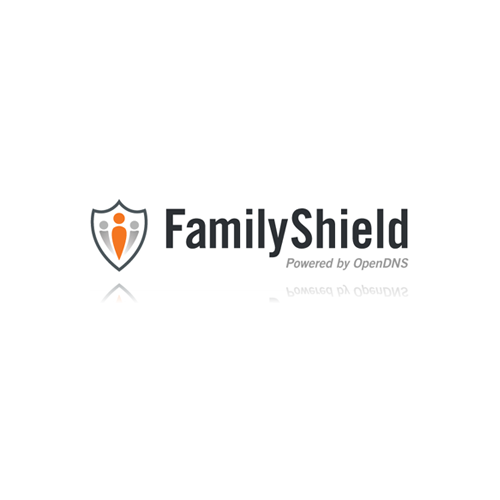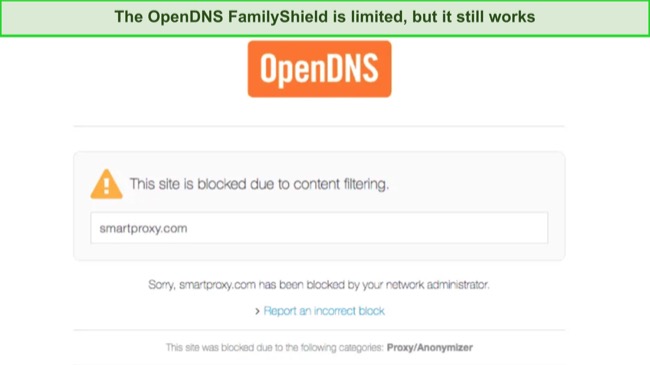OpenDNS Family Shield Review 2025: Before You Buy, Is It Worth It?

OpenDNS Family Shield Overview
I started using OpenDNS FamilyShield to see if there’s finally a good free parental control solution. There’s no software to install, I just needed to change the DNS numbers on my router and it started working on all the connected devices in the house.
The main feature is a web filter. It did a good job blocking adult websites, proxies, and “tasteless” sites. It also blocks phishing attacks and most malware, which keeps kids safe as they browse the web. However, there’s no option to block websites with violence, gambling, and other types of inappropriate content.
As with most free parental control solutions, you’re much better off using a trusted app like Qustodio. Its features include a comprehensive web filter, multiple screen time tools, live location tracking, and detailed reporting. It also comes with a 30-day free trial so you can test the features yourself.
Try Qustodio free for 30 days!
In a Rush? Here’s a 1-Minute Summary of FamilyShield
- Web filter blocks adult content: The web filter blocked websites it categorized as tasteless, proxy/anonymizer, sexuality and pornography. However it doesn’t block other inappropriate websites. Learn more about the web filter here.
- Enhanced security protection: The basic security feature protects your children against basic phishing attacks and some malware, but not against advanced attacks. See how it works here.
- No software or installation necessary: The parental control works at the network by changing the DNS numbers in your router, but it can easily disabled by changing the DNS numbers back to the default on the child’s device. Read the setup guide.
Features
The best way to describe OpenDNS FamilyShield is: very basic. It lacks most of the standard parental control features that are found in premium apps. There are no screen time controls, you can’t block apps, no social media monitoring, and no location tracking. In fact, if your child leaves the house or connects to a hotspot, the web filter won’t work.
You are better off investing in your child’s online health and getting a premium parental control app. Among all the premium parental control apps I’ve tested, Qustodio had the most comprehensive features and performed the best. The web filter has 29 categories, there are 3 screen time tools, it monitors phone calls and messages, tracks live location, and generates daily reports.
With that being said, here are the key features that you’ll find if you activate OpenDNS FamilyShield.
The Web Filter Works But It’s Very Limited
I’ll start with the good news; I tried opening several porn sites, but they were blocked. According to the official website, FamilyShield only blocks tasteless, proxy/anonymizer, sexuality and pornography websites. The filter is preconfigured, meaning you don’t need to adjust any settings. However, it also means that it’s not customizable and you can’t block specific URLs.
The Tasteless category is a collection of websites that feature gore, suicide, horror, and other objectionable content. However, there’s nowhere on the OpenDNS FamilyShield website that gives a complete list of what defines tasteless. You’re essentially trusting the web filter will block any sites that you don’t want your child to see.
The fact that it blocks proxies and anonymizers, such as VPNs and proxy websites is important. When activated, these tools can bypass the OpenDNS FamilyShield settings. I did discover that my kids can connect to a VPN on a data network or public WiFi, and stay connected when they get home, bypassing the web filter.

Overall, the web filter worked and blocked the websites that triggered its filters. However, it’s a small percentage of the types of websites that should be filtered to keep kids safe online. Especially when compared to a parental control app like Qustodio which has a comprehensive web filter with 29 adjustable categories.
Improve the Security of Your Child’s Devices
OpenDNS FamilyShield blocks malicious websites, phishing attacks, and malware. While it’s not the same as blocking porn, it will protect your child from hackers or fake sites designed to steal passwords and credit card information. This isn’t a typical feature included in most parental control apps, although I have seen it with Norton Family and Aura.
The tool also identifies and restricts access to websites categorized as risky, enhancing overall browsing safety. However, for more advanced threats or detailed threat analysis, additional security measures might be necessary. OpenDNS Family Shield is only good enough to provide a primary layer of defense, not as a comprehensive security solution.
Installation
There is no installation required to enable OpenDNS FamilyShield. All you need to do is change the DNS numbers to activate its parental control features.
There are 2 options for setting up OpenDNS FamilyShield:
- Enabling it on your router: This enforces the web filter and security features on any device that connects to your network.
- Enable it on specific devices: You can change the DNS on Windows, Mac, Android, and iOS.
How to Set Up OpenDNS FamilyShield on a Router
Before you get started, you will need the URL address for your router. Every router is different, so these instructions are pretty general:
- Open the router settings page.
- Find the DNS server settings.
- Replace your current DNS server addresses with the OpenDNS FamilyShield servers: 208.67.222.123 and 208.67.220.123.
- Save the changes and restart your router to apply the new DNS settings.
- You can verify the configuration by visiting the OpenDNS website, which will confirm if your internet is now using their DNS servers.
How to Set Up OpenDNS FamilyShield on Windows
- Right-click your mouse on the Windows logo and click Network Connections.
- Open the Ethernet tab and select the Change Adapter Options.
- Right click on your network and click the Properties option.
- Locate Internet Protocol Version 4 (TCP/IPv4) on the list and click the Properties button.
- In the Use the Following DNS Server Addresses section, enter the DNS numbers 208.67.222.123 and 208.67.220.123.
- Clean your computer’s cache by typing cmd in the Start menu. The Command Prompt will open, write ipconfig/flushdns and press the Enter key.
- Clear the cache on your browsers.
How to Set Up OpenDNS FamilyShield on Mac
- Click on the Apple logo and open the System Settings.
- Open the Network tab and select Details next to your internet connection.
- Click the + icon next to the DNS tab and enter the DNS numbers 208.67.222.123 and 208.67.220.123.
- Tap the command and spacebar at the same time and type Terminal. Type “sudo dscacheutil -flushcache; sudo killall -HUP mDNSResponder” to clear the DNS cache.
How to Set Up OpenDNS FamilyShield on iOS
- Open the Settings window and make sure your Wi-Fi is active.
- Tap the blue “i” icon and select Configure DNS and then choose the manual option.
- Click Add Server and enter the DNS numbers 208.67.222.123 and 208.67.220.123.
How to Set Up OpenDNS FamilyShield on Android
- Pull down the main menu and tap Settings.
- Click on Connections and then select your Wi-Fi connection.
- Tap Advanced and switch your IP Setting to Static.
- Add the DNS numbers 208.67.222.123 and 208.67.220.123 and save your settings.
Ease of Use
Once you change the DNS settings there is nothing to do. OpenDNS FamilyShield has no apps, dashboard, or reports. It’s all preconfigured and runs by itself.
The downside of having such a basic setup is that you can’t customize it for your child. A better option is Qustodio, which is also easy to set up and manage. You can adjust the web filter, set up screen time controls, block apps, and view reports all from a cloud-based dashboard.
Support
It shouldn’t be a surprise that the free OpenDNS FamilyShield doesn’t have live chat support. If you need help, your best option is to read through the community forum to see if anyone else had the same issues. Make sure to pay attention to the date, or you might find outdated information.
There is the option to submit a ticket to the general OpenDNS support staff. Immediately after sending my question, I got an automated response with links to knowledgebase articles that had similar keywords to my request. I had to wait 8 hours before receiving an answer to my question from someone on the technical support staff.
FAQs About OpenDNS FamilyShield
Is OpenDNS FamilyShield free?
Is OpenDNS Family Shield a reliable parental control app?
What types of websites can OpenDNS FamilyShield filter?
Pricing
OpenDNS FamilyShield is 100% free. It’s not only free in terms of cost, it’s also free from basic features, free of advanced features, from dashboards you use to monitor your kids, free of apps, and free from real value.
I usually grade pricing as more than just the cost, but the value as well. This app has little value, other than a basic web filter, and so, even for a free app, I feel like you’re not getting a good value.
Bottom Line
OpenDNS FamilyShield is an extremely basic parental control tool. You don’t need to buy anything or install any apps on your device. Instead, just change the DNS numbers on your router or child’s device, and it activates a preconfigured limited web filter. It also has security tools that block risky websites, phishing attacks, and some malware.
That’s it. If you’re serious about parental controls and limiting screen time, filtering more than just porn and tasteless websites, want to have the ability to manage app use, and to view reports on your child’s activity – then this isn’t the parental control for you. A better option would be Qustodio, which offers comprehensive parental control protection.
It has an adjustable web filter with 29 categories, 3 screen time control features, remote app management, live location tracking, call and message monitoring, and detailed reporting going back 30 days. What’s even better, you can try Qustodio free for 30 days for a risk-free evaluation, so you can see if it’s the right app for your needs.



